 USA (1917) – USS New mexico, Mississippi, Idaho
USA (1917) – USS New mexico, Mississippi, IdahoWW1 US Battleships:
USS Maine | USS Texas | Indiana class | USS Iowa | Kearsage class | Illinois class | Maine class | Virginia class | Connecticut class | Mississippi class | South Carolina class | Delaware class | Florida class | Arkansas class | New York class | Nevada class | Pennsylvania class | New Mexico class | Tennessee class | Colorado class | South Dakota class | Lexington class
The New Mexico, Idaho and Mississippi at Pearl Harbor in December 1943
Battling vets of two world wars: About nine classes of battleships went through both world wars, two from UK, Japan, France and Italy, and five from the USA. In the latter case, the two oldest even saw action under a Greek flag after being sold. The three New Mexico were the last class to enter service and see little action during the closing month of 1918. They were launched indeed in January-June 1917 and of a brand new radical design.
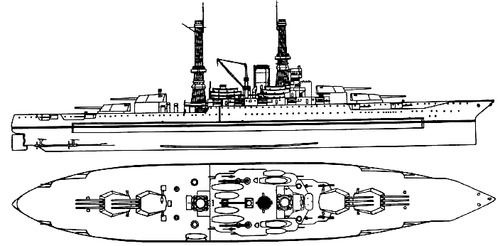
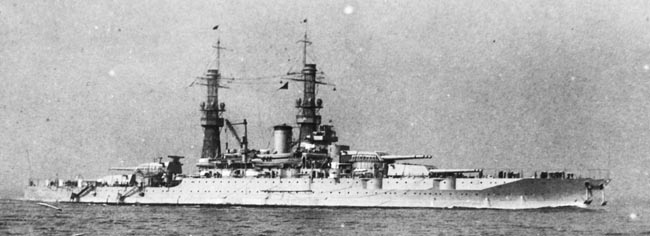
The BB 40 class included the New Mexico – in service in May 1918, Mississippi, in service in December 1917 and Idaho, in service after the war in February 1919. Originally designed at 32,000 tons, they differed from the previous Pennsylvania by their more modern hull with a clipper bow, abandoning the old spur in favor of a more marine and functional shape. However, like the latter, they kept the four triple turrets arrangement allowing to stack a broadside of twelve 15 in (356 mm) guns. The secondary battery used the standard 127mm guns in barbettes. Their silhouette was recognizable by their typical corbelled cage masts, adopted during construction. They would be completely reconstructed in 1931-34 and became new ships at least in appearance, ready to take on another conflict.
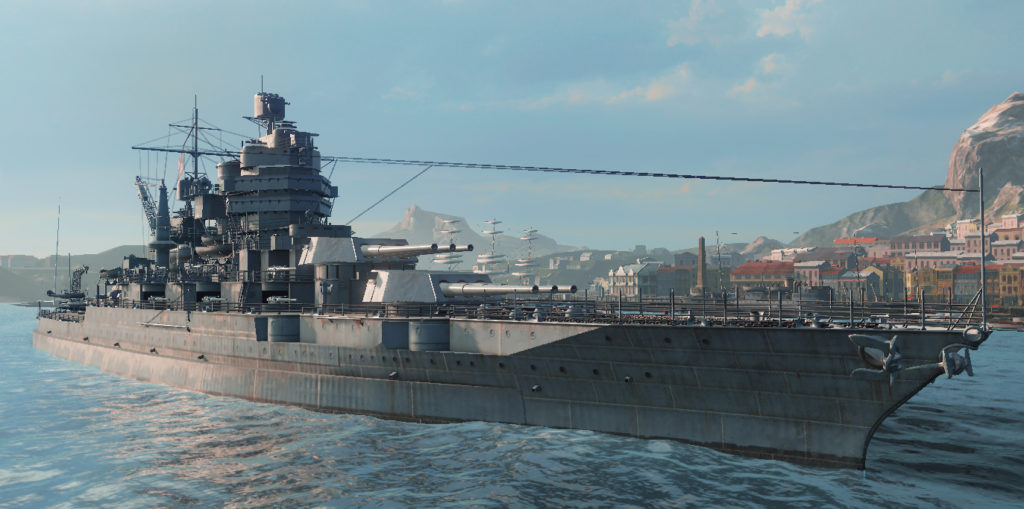
3D rendition of the USS New Mexico in world of warships
From 1942, they joined the Pacific, replacing the losses of Pearl Harbor and receiving a radar. Outside the Washington and North Carolina classes, they were the most modern BBs in the US Navy, did not suffer any really serious damage in operations while taking their fair share of operations throughout the Pacific campaign. The old vets were eventually withdrawn and stricken in 1948, the last dismantled in 1956.
Development of the second standard battleships
As part of the 1915 naval plan, these battleships were closely modelled on the previous Pennsylvania. The latter introduced a battery of four triple turrets with 14-inch (356 mm)/45 caliber guns. This was the second standard type battleship class to be defined for the US Navy, which included the latter New Mexico and the following Tennessee and California classes.
The New Mexico only innovated by a clipper bow, and the class was part of a design concept giving the Navy a homogeneous line of battle. These ships had the same long-range gunnery and a moderate speed of 21 knots (39 km/h; 24 mph) plus 700 yards (640 m) tactical turn and improved damage control and ASW protection. The second standard were the Nevada and Pennsylvania. The lineage started as a 1911 requirement included in the 1913 naval plan for the Pennsylvania class. They were considered “super-dreadnought” and innovated with the adoption of the”all or nothing” armor concept, oil fuel, and steam turbines with geared cruising turbines.
Design of the New Mexico
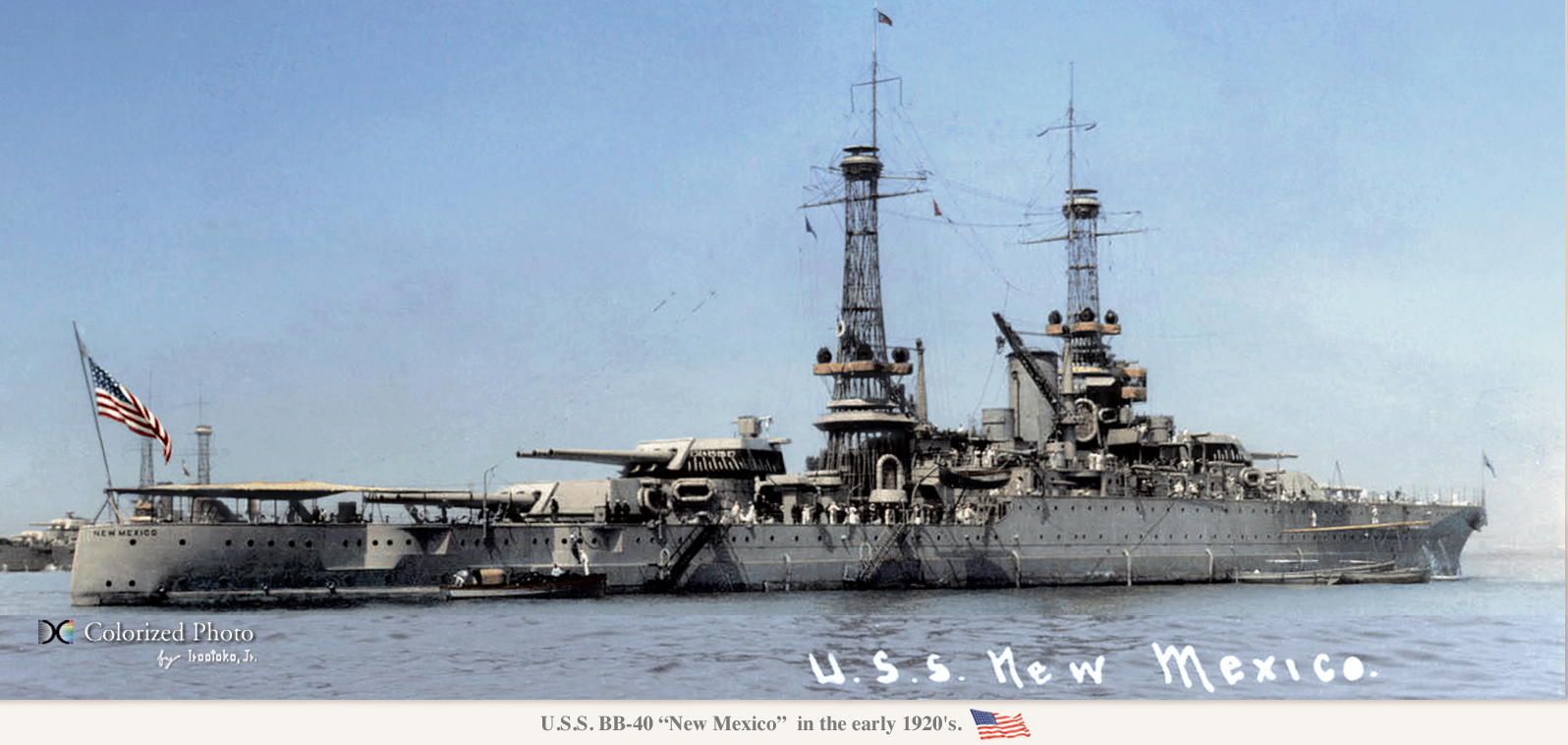
New Mexico 1921 – colorized by Hirootoko Jr.
The New Mexico were 624 feet in length (190 m) with a 97 ft 5 in (29.69 m) beam and 30 ft (9.1 m) draft, traduced into a 32,000 long tons (33,000 t) diplacement as designed. Completed they displaced 33,000 long tons (34,000 t) full loaded, combat-ready.
Powerplant
The New Mexico innovated by adopting four-shaft General Electric steam turbines fitted with a turbo-electric transmission. These were fed by nine oil-fired Babcock & Wilcox boilers. The powerplant was rated at 27,500 shaft horsepower (20,500 kW). Top speed as designed and required was 21 knots (39 km/h; 24 mph). Range was also defined to be 8,000 nautical miles (15,000 km; 9,200 mi) at 10 knots (19 km/h; 12 mph). The New Mexico class was also fitted with the “caorbel” masts, typical lattice construction with spotting tops to conduct fore on the main gun battery.
Protection
Armor was based on the “all-or-nothing” scheme of the previous Pennsylvania. The main belt was 13.5 in (343 mm) thick, down to 8 in (203 mm on both ends and upper and lower parts) and the main deck up to 3.5 in (89 mm). The main turrets were given a 18-in (457 mm) thick face, 9 to 10 in (229–254 mm) sides, 5 in (127 mm) top and 9 in (229 mm) rear face. The barbettes were 13 in (330 mm) in thickness and the conning tower was a 16 in (406 mm) cylinder, down to 11.5 in (292 mm). The decks were slightly better armoured than on the Pennsylvania (1.5–3 in or 38–76 mm), and presumably the blukheads were of the same thickness of 13–8 in (330–203 mm).
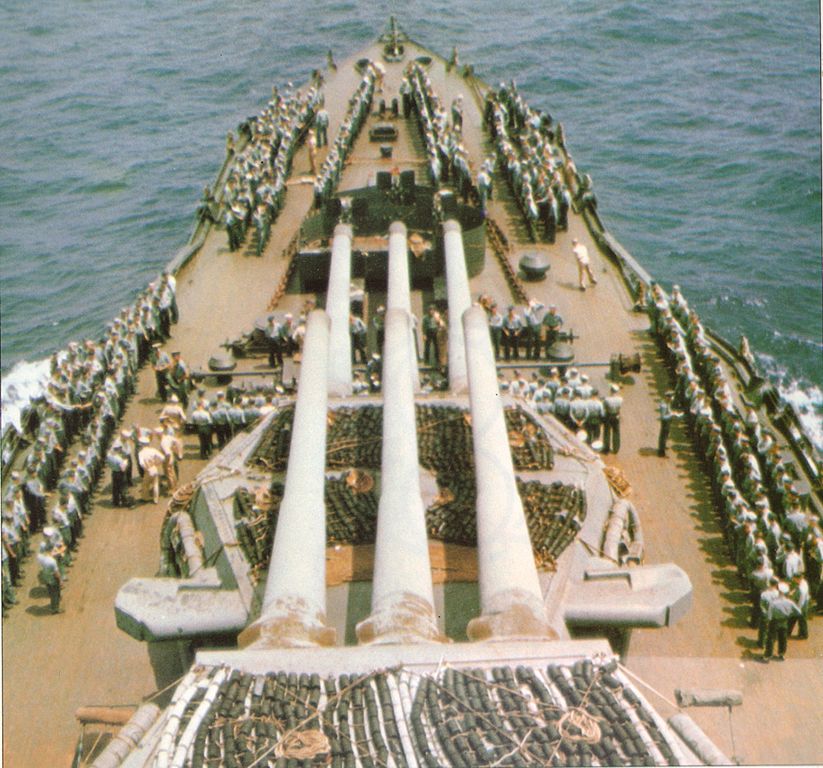
Forward deck showing the artillery
Armament
The main battery comprised twelve 14-inch (356 mm)/50 caliber guns. They were placed in four three-gun turrets, all on the centerline in superfiring pairs forward and aft. This allowed a complete broadside and six guns in chase and retreat. Also for the first time, the mounts were fully separated, each barrel elevating independently. The secondary battery comprised fourteen 5-inch (127 mm)/51 standard guns. They were all given individual casemates clustered in the superstructure and hull. Four were placed in the upper hull, after and four more forward, and six facing forward in the main superstructure amidship and four more in retreat.
The initial battery was twenty-two, but experience in the North Sea already demonstrated that hull guns were unusable in rough seas which were common. Soon, these guns were removed and the casemates plated over. Also, the superstructure deck received four 3-inch (76 mm)/50 caliber pieces, which were used as dual purpose guns. For close quarters, the three New Mexico ships were also given two 21-inch (530 mm) torpedo tubes submerged in the hull on the broadside.
1931 rebuilding
After the arrival of the “big five” in the early 1920s, they were stationed for their entire peace career in the Atlantic. In 1931, they began a more radical reconstruction than all other American battleships: Their old engines were removed and replaced by modern turbines, their speed went up to 22 knots, despite an increase in weight because their frail masts were removed and replaced by a solid and impressive blockhouse tower and another at the back. Their barbettes hull guns (remaining) were removed and the openings welded shut. They kept only the 6 casemate guns in the front battery. 8 others dual purpose guns were added on the deck of the same battery, in anti-aircraft mounts. Systematic electric lighting and air conditioning helped to eliminate most of the portholes. Their rangefinders were also completely new. The three ships emerged from this yard in 1934.
The BB40 in action:
USS New mexico (BB40), “the Queen of the Fleet”
The New Mexico in the Great war
Only the USS New Mexico (New York, Brooklyn Navy Yard) and Mississippi (Newport News Shipbuilding, Newport News) were completed, made their trials, and were commissioned to take part of the 1918 operations of the US Navy in the Atlantic. New Mexico started operation on 20 May 1918. In September, she operated from Boston and was at the New York naval review on 26 December, escorting later the SS George Washington carrying President Woodrow Wilson to France for the Versailles Peace Conference in January 1919.
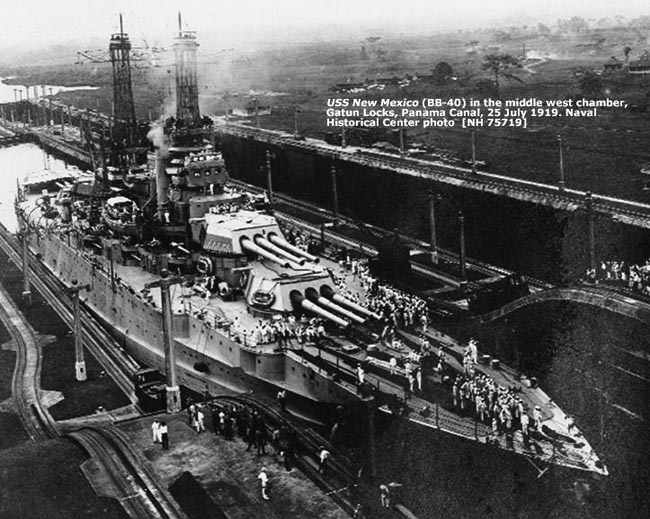
The interwar
From July 1919 she operated from Hampton Roads, Virginia and passed to the Pacific Fleet as flagship and passed through the Panama Canal. She was based at San Pedro. In 1922 two of her secondary guns were removed and she went through a limited refit. For the next 12 years exercises followed in a routine with the Carribean, Atlantic and Pacific fleets and some long range cruises. In 1931-33 the ship was at Philadelphia NyD for a massive refit, receiving 5-inch/25 caliber anti-aircraft guns, and many other additions.

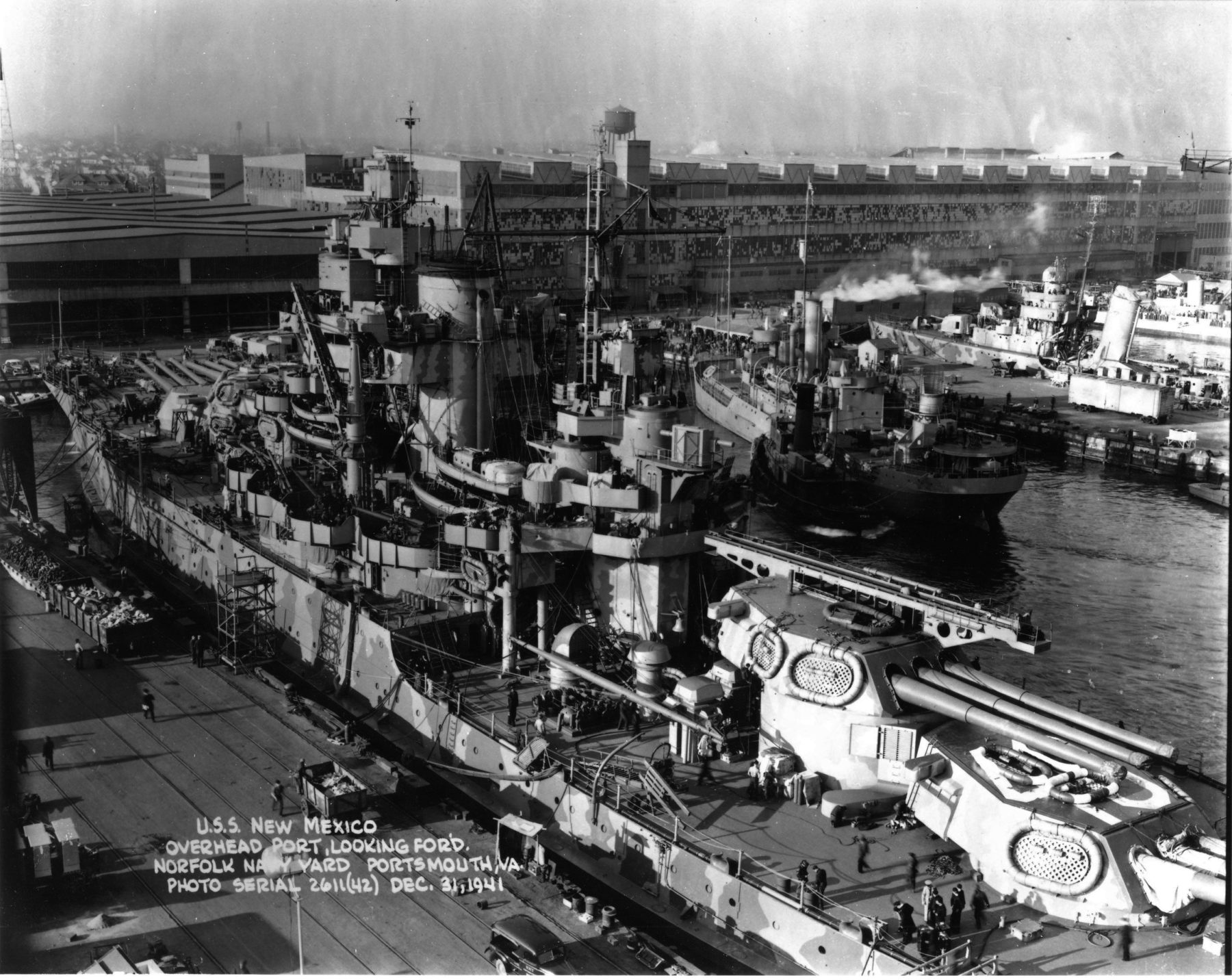
USS New mexico at Puget Sound in 1942, with the wave grey camouflage of the time
New Mexico was based at Pearl Harbor, Hawaii until 20 May 1941 and then joined the Atlantic fleet. She patrolled from Norfolk along the coast, making the week-long “shifts” escort convoys. On 10 December she rammed and sank by accident the SS Oregon off Nantucket and was back to cross Panama in January 1942. She was overhauled in May at Puget Sound with modern AA guns added. She sailed to Hawaii and escorted convoys to the Fiji Islands. She also took part in the Aleutian Islands Campaign and covered the attack on Attu and shelled Kiska, driving out the Japanese a week later.
After a short refit at Puget Sound Navy Yard she transited via pearl harbor to take part in assault on the Gilbert Islands. She attacked Makin Atoll and provided anti-aircraft cover for supplies and troops.
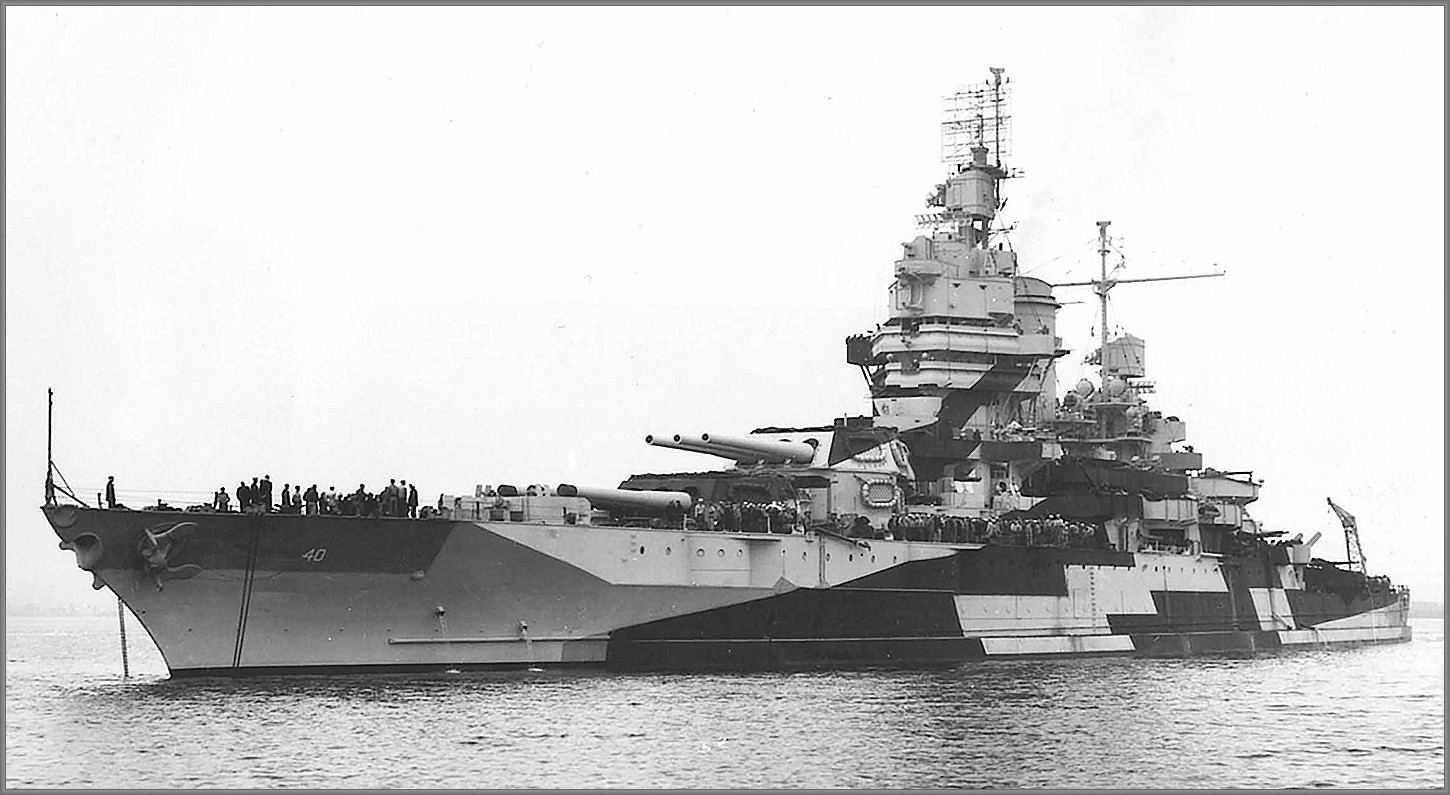
In 1944, New Mexico took part in the Marshall Islands campaign on 12 January, shelling Kwajalein, Ebeye, Wotje, New Ireland and Kavieng. She sailed to the Solomon Islands for practice, firing on the Mariana Islands and made a stop in Australia on the way. She also bombarded Tinian, Saipan and Guam. Her AA battery fended off two several Japanese air attacks, and escorted a convoy to the Mariannas, missing the Battle of the Philippine Sea. After a stop at Eniwetok and other escort missions she shelled Guam during july 1944. After a new overhaul at Bremerton (Washington) she sailed to the Leyte Gulf fending off many air attacks throughout the Philippines campaign. Afterwards she escorted a convoy between the Palaus and Mindoro.
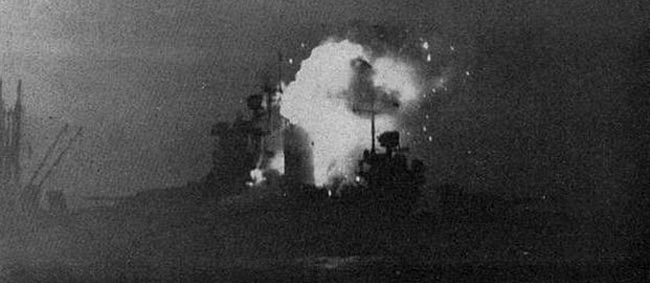
USS New Mexico hitby a kamikaze off Okinawa, 12 May 1945
In 1945 she was back in the Philippines, covering the assaults on Luzon. Off Lingayen Gulf in January she was attacked by kamikazes. One managed to get through and hit the bridge, killing 87 including Lieutenant General Herbert Lumsden, British representative to General Douglas MacArthur while Bruce Fraser, the commander of the British Pacific Fleet was wounded. She was summarily repaired to continue providing fire support and returned to Pearl Habor for more extensive repairs. She then sailed to Okinawa and started shelling the devil island on 26 March, provided fire support for a whole month of operations, destroying eight incoming Shinyo suicide boats in the process. However she was attacked by Kamikazes again off Hagushi anchorage in May.
She was badly hit and was set on fire with 54 crew dead, 119 wounded, while the fire was contained and extinguished after 30 minutes. She was repaired later and prepared for the planned invasion of mainland Japan. She was at Saipan when the war ended, sailing to Okinawa to cover the occupation force at Sagami Wan and Atsugi Airfield. She also sailed in tile to Tokyo Bay to see the Japanese capitulation signed on 2 September. After the war, she was scrapped in 1948 at Newark.

BB40 in front of Fuji-San, Tokyo bay, August 1945.
The unlucky USS Mississippi (BB41)
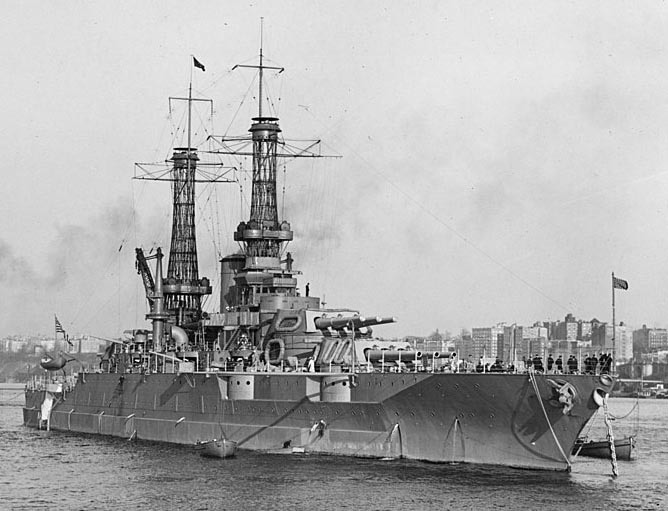
She was the first of her class in service in 18 December 1917, commanded by Captain Joseph Lee Jayne. She started in the Carribean for training, in the Gulf of Guacanayabo in Cuba and served from Hampton Roads, Virginia, and cruising between Boston and New York. After 1919 she was transferred to the Pacific Fleet, and in 1923 during an exercise sank the old pre-dreadnought Coast Battleship No. 4 (USS Iowa). She also suffered and accidental explosion in her forward superfiring Gun Turret No. 2. She underwent a major refit at Norfolk Navy Yard that began on 30 March 1931. After her refit she returned to the Pacific, and served there until the war broke out.
Wartime operations

Mississippi after refit in the late 1930s
On 7 May 1941, she was ordered to the Atlantic by Admiral Harold Rainsford Stark, like her sister ships, the aircraft carrier Yorktown, cruisers and destroyer squadrons. She took part in neutrality patrols until the attack of Pearl harbor, when she was just in transit between Iceland and San Francisco on the Pacific coast. She started operations from there in 22 January 1942, patrolling and escorting troops to the Fiji Islands. She joined Pearl Harbor on 2 March 1943. She then took part in the liberation of the Aleutian Islands. After this mission she was back to San Francisco for an overhaul. She then departed to take part in the Gilbert and Marshall Islands campaign, shelling Makin and suffering a grave explosion in her No. 2 turret, which killed 43.

Mississippi in January 1942
After repairs she soldiered at Kwajalein, bombarding Japanese positions at Taroa, Wotje and later Kavieng on New Ireland. She received another ovehaul at Puget Sound and was back in action this time to cover the Marines at Peleliu. In october she was placed under the command of Rear Admiral Jesse B. Oldendorf to take part in the invasion fleet for the Philippines. She took part in the epic battle of Leyte Gulf on the night of 24 October 1944, repelling the Japanese Southern Force (Vice Admiral Shōji Nishimura) at Surigao Strait. Helped by their radars, Mississippi and other battleships spotted the Japanese at the entrance and opened fire with full broadsides, crippling the Japanese. This was her only ship-to-ship engagement in both world wars. But this was short as her old radar did not allowed any clear recognition of targets, and she fired just one salvo before being ordered to stop.
After this battle she stayed covering next operations until 16 November, hopped to the Admiralty Islands to resupply and returned to San Pedro Bay and operated around Luzon. During these operations she was attacked by several kamikazes and one get through her defenses. She was hit but apparently with moderate gravity and continued shelling Japanese positions. She then departed to Okinawa, anchoring off Nakagusuku Wan on 6 May and shelling Shuri Castle and other points of the fortified line. She was hit again by another Kamikaze on 5 June 1945. She later departed to Sagami Wan, Honshū, arriving there on 27 August 1945 and was present at Tokyo Bay the day of the capitulation. However she did not remained with the occupation force and steamed back to Norfolk NyD.
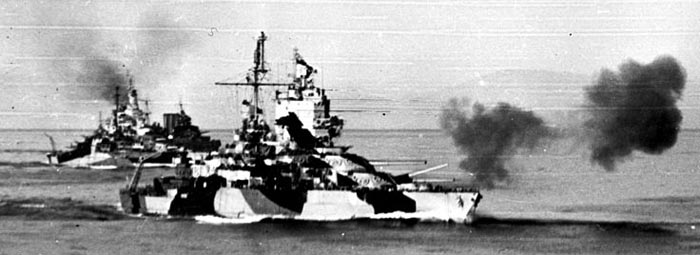
Mississippi shelling Luzon in 8 January 1945 together with West Virginia and HMAS Shropshire.
Postwar: Mississippi as a missile battleship
Indeed, at Norfolk, the battleship was not de-commissioned but instead converted into a gunnery training ship, hull number AG-128 on 15 February 1946. There, she was modified: Her no. 1 turret was replaced by a twin 6-inch (152 mm)/47 cal. dual-purpose turret (Worcester class), No.2 and No.3 turrets were removed and only N°4 was kept. She also received samples of the latest in US Navy secondary armament, three twin 5-inch (127 mm)/38 dual-purpose semi-automatic turrets, two single 5-inch/54 caliber DP turrets of the Midway class type, two twin 3-inch (76 mm)/50, and two quad 40 mm Bofors AA. She served from November 1945 through April 1948 but was only operational from 18 March to 15 May 1947. She was also the flagship of Atlantic Fleet until 14 July 1947 and replaced Wyoming as an anti-aircraft training ship.

BB41 as a training ship in 1949
Then came the last refit of the veteran, in drydock at Norfolk Naval Shipyard. She was reconstructed to be used with the operational development force. She spent her last years making gunnery tests and evaluating new weapon systems. Most remarkable was her fitting of two brand new and untested RIM-2 Terrier missile launchers. These were installed in 1952 in place of No. 4 turret. She, therefore, was the first USN ship to fire the Terrier missile took, in 28–29 January 1953, off Cape Cod. She would also test the Petrel missile assisted by an early radar-homing system in February 1956. She was by then the only missile battleship afloat -and remained so until the rebuilt Iowa class in the 1980s- bridging a gigantic gap in weapons technology spanning two world war, almost a symbol of it. On 17 February, after all these service years, USS Mississippi was eventually decommissioned at Norfolk. She was sold for scrap to Bethlehem Steel and later broken up.

USS Mississippi as a missile cruiser in 1955.
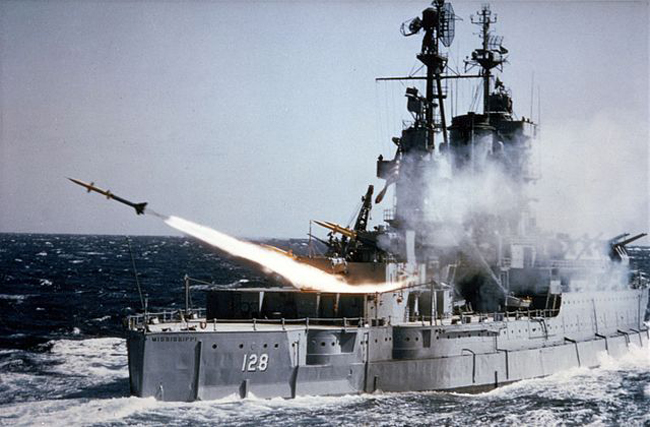
USS Idaho (BB42)
Idaho was the only one in the class to not see service during the Great war. She was indeed commissioned in 24 March 1919. Her first shakedown cruise was made between Cuba and New York. she carried back Epitácio Pessoa, the president of Brazil from a state visit, reaching Rio de Janeiro on 17 July, then went north and passed through the Panama Canal, joining Monterey, California, Pacific Fleet. She multiplied yearly exercises for years, cruising along South America, as far south as Chile and participating in many Naval Reviews. She later toured the southern Pacific, based in Hawaii and joined San Pedro as a regular base.
After her reconstruction in October 1934 she returned to San Pedro and in mid-1940, joined Hawaii amidst tensions with Japan. However she passed the Panama canal once more to join Neutrality Patrols to protect American shipping, from May 1941 operating from Hampton Roads and later Hvalfjörður, Iceland, and was stationed there when the attack of Pearl harbor took place. From then on, BB42 left Iceland on 9 December 1941 to return to the Pacific Fleet, stopping in Norfolk, then Panama and San Francisco in January 1942. She trained however along the coast of California and in October 1942 underwent a refit at Puget Sound, her old guns removed to serve on merchant ships. On April, 7, she steamed to the Aleutian Islands, bombing Attu, covering the assault. She then swapped to Kiska, and later returned to San Francisco to prepare for a major operation in the Gilbert Islands.
She bombarded Makin Atoll on 20 November 1942 USS Idaho and other positions on the Gilberts while also covering the skies with her large A battery. In December, she was sent to the Marshall Islands. In January 1944 she shelled Kwajalein, and afterwards resupplied at Majuro before resuming her attacks on other islands of the Marshalls, then was sent to Kavieng, New Ireland for a diversionary shelling on 20 March 1944. Five days after, she was in the New Hebrides, then Australia to resupply and resting the crew before returning to Kwajalein in June, and then joining the invasion force bound for the Mariana Islands. She shelled Saipan on 14 June, then Guam. She was also present at the Battle of the Philippine Sea in June, and resupplied to Eniwetok in the Marshalls. She resumed shelling Guam to cover assaults and returned to Eniwetok in August, then joined Espiritu Santo floating dry dock.
In 1921, she was given aircraft catapults, of the Mark II type. From 1831 she underwent her reconstruction, with new geared Westinghouse turbines, six new oil-only express boilers (Bureau of Engineering) allowing to reach of 22 knots (41 km/h; 25 mph) with 40,000 horsepower. The main caliber guns had new mounting allowing 30 degrees elevation for a better range, two barbettes 5-inch removed, eight new 5-inch/25 AA installed on the battery roof. The armored deck receive 2-inch (51 mm) or extra armor, ASW protection was improved with new bulkheads. Masts were replaced by solid blockhouses with a light pole instead. The tower comprised accommodations as a flagship, with a flag bridge for the admiral. However displacement rosed to36,157 long tons (36,737 t) fully loaded.
Her third refit occurred in late 1942, with the addition of ten quadruple Bofors 40 mm guns, forty-three 20 mm (0.79 in) Oerlikon guns (total in 1945), only sixteen in 1942, eleven more in January and February 1944. From October 1944 to January 1945, she was the only one of the class to receive ten brand new 5-inch/38 caliber guns in modern dual-purpose mounts, replacing the old models and the new Mark 8 radars.
1945 campaigns
In September 1944 she was at Guadalcanal for amphibious assault training but soon steamed to Peleliu. In close coordination with the Marines she relentlessly shelled well entrenched, fortified Japanese for days. After returning to Washington in October where she was refitted with new 5-in DP guns, she was sent to do training off California. In January 1945, she departed San Diego to Pearl Harbor and then proceeded to the Marianas and then in February took part in the battle of Iwo Jima staying here for a month. In March 1945 she was sent to Ulithi.
Later she joined Rear Admiral Morton Deyo and took part in the Battle of Okinawa shooting down five kamikazes and later left for Guam, repaired and sent back to Okinawa on 22 May. She departed on 20 June for the Philippines and operated in Leyte Gulf until the 15 August surrender. She was also present in Tokyo Bay on 27 August and was later back to Norfolk on 16 October. She was decommissioned on 3 July 1946, sold for scrap on 24 November 1947.
Specifications
New mexico 1917
Displacement: 32,000 long tons (32,514 t) standard
Dimensions: 190,19 m long, 32,40 m wide, 9,44 m draft (624 ft, 97 ft 5 in, 30 ft)
Machines: 4 propellers, 4 Curtiss turbines, 8 boilers, 21,000 hp.
Maximum speed: 21 knots
Shield: Belt: 8–13.5 in (203–343 mm) Turret (face): 18 in (457 mm), Conning tower: 11.5 in (292 mm), Decks: 3.5 in (89 mm)
Armament: 12 × 14 in (356 mm)/50, 14 × 5 in (127 mm)/51, 8 × 3 in (76 mm)/50, 2 × Mark 15 21 in (533 mm) TTs
New mexico 1941
Displacement: 34,420 t. standard -36 160 t. Full Load
Dimensions: 190,19 m long, 32,40 m wide, 9,44 m of draft
Machines: 4 propellers, 4 Westinghouse turbines, 4 Express boilers, 40,000 hp.
Maximum speed: 22 knots
Shield: Belt 350, turrets 400, bridges 152, inner casemate 287-400 mm, blockhouse 400
Weaponry: 12 x 356 (4 × 3), 14 x 127, 24 x 40 (6 × 4), 16 x 20 mm AA (43 1945), 3 planes
Crew: 443
Sources, read more
history.navy.mil/research/histories/ship-histories/danfs/n/new-mexico.html
https://en.wikipedia.org/wiki/New_Mexico-class_battleship
https://www.history.navy.mil/our-collections/photography/us-navy-ships/battleships/new-mexico-bb-40.html
https://www.the-blueprints.com/blueprints/ships/battleships-us/page/2/
http://newmexicohistory.org/people/uss-new-mexico-the-queen-of-the-fleet
https://ww2db.com/ship_spec.php?ship_id=338
http://www.steelnavy.com/IS%20New%20Mexico.htm
http://www.researcheratlarge.com/Ships/BB40/BOGP/BOGP_187529_Sheet1.jpg
(in your browser, replace “…_Sheet1.jpg” by “…_Sheet2.jpg” and following to see the original plans
Conway’s all the world fighting ships 1860-1905, 1906-1921.

USS Mississippi in 1917, just entering service, (Atlas Editions, weapons encyclopedia)


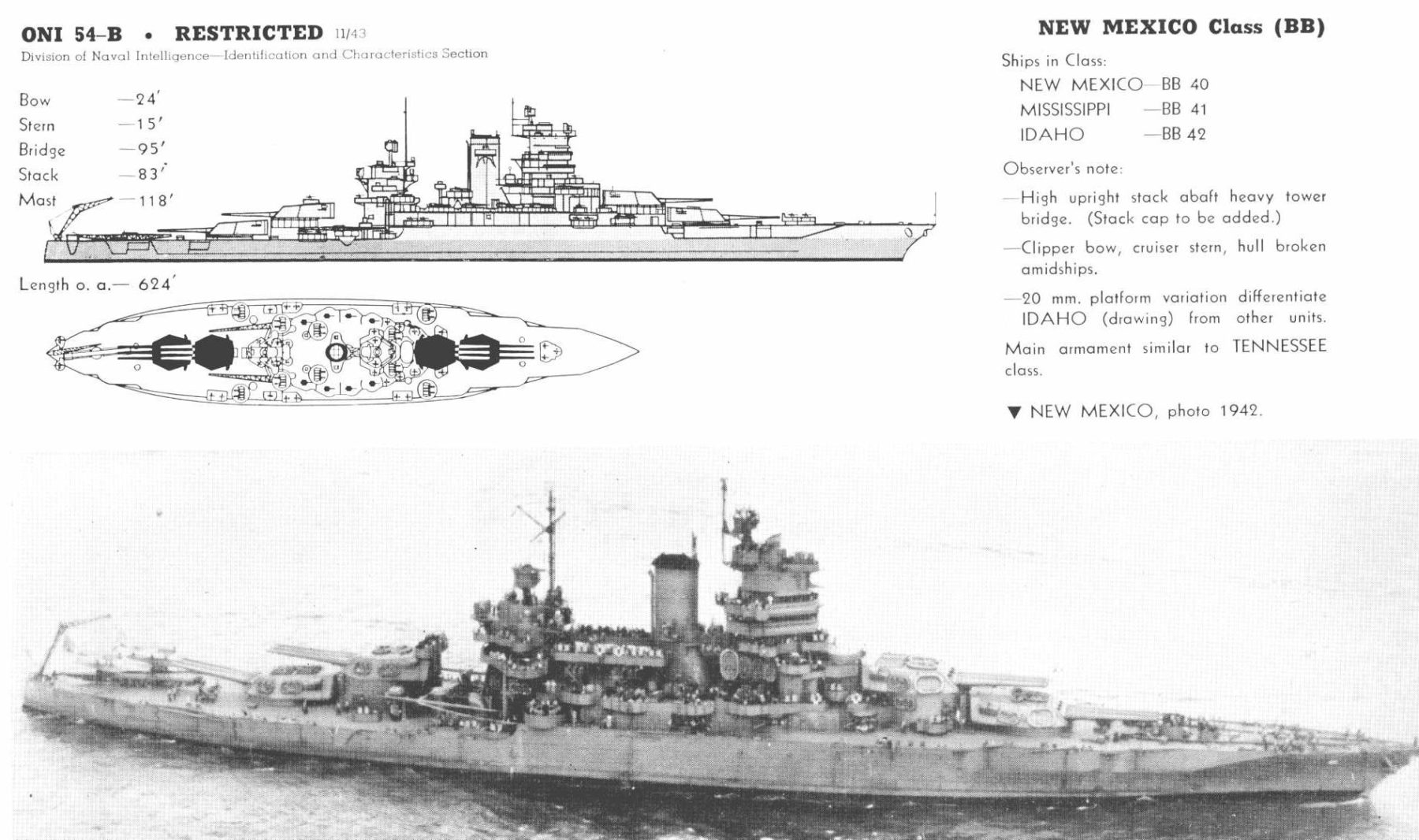
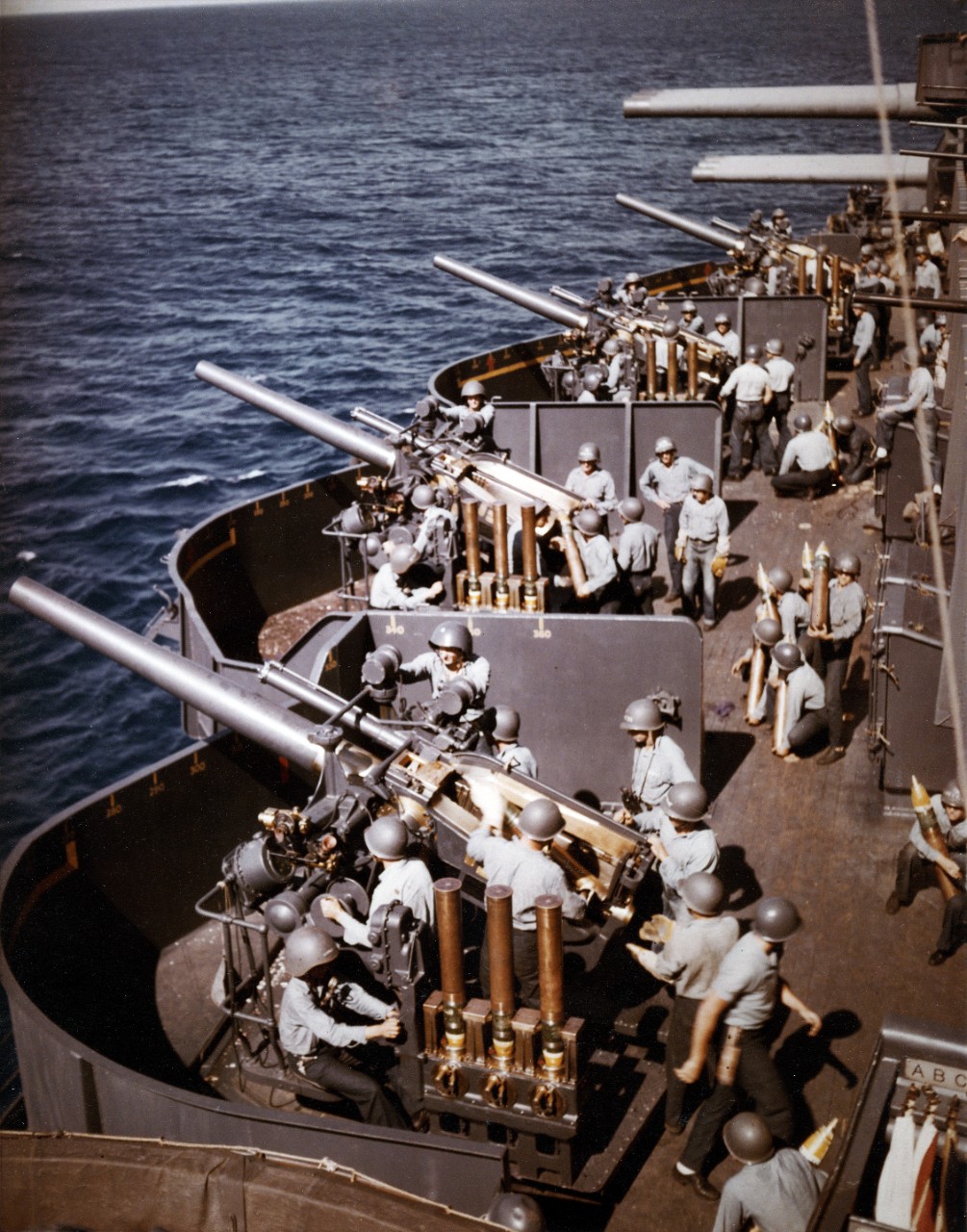
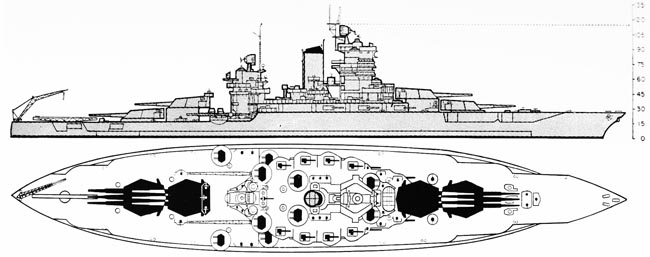
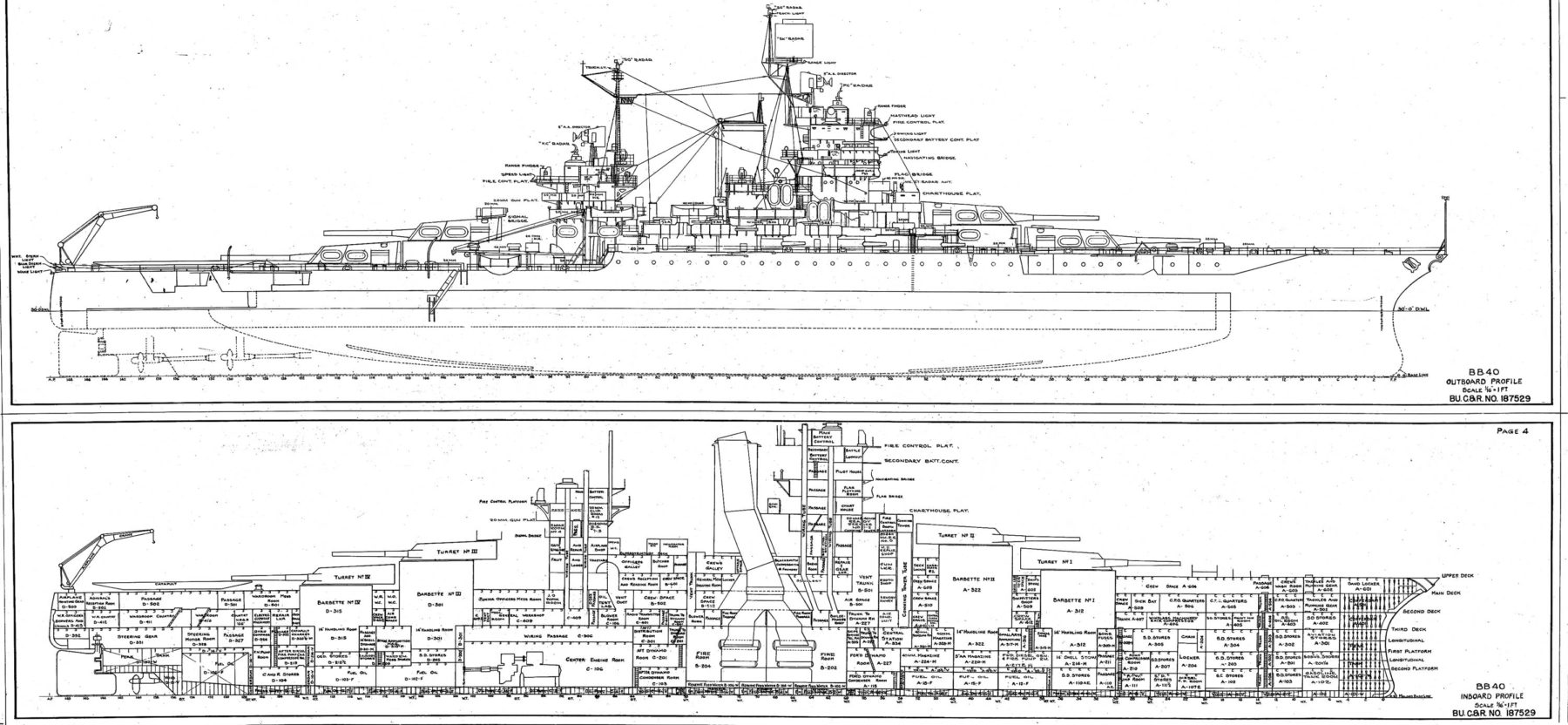

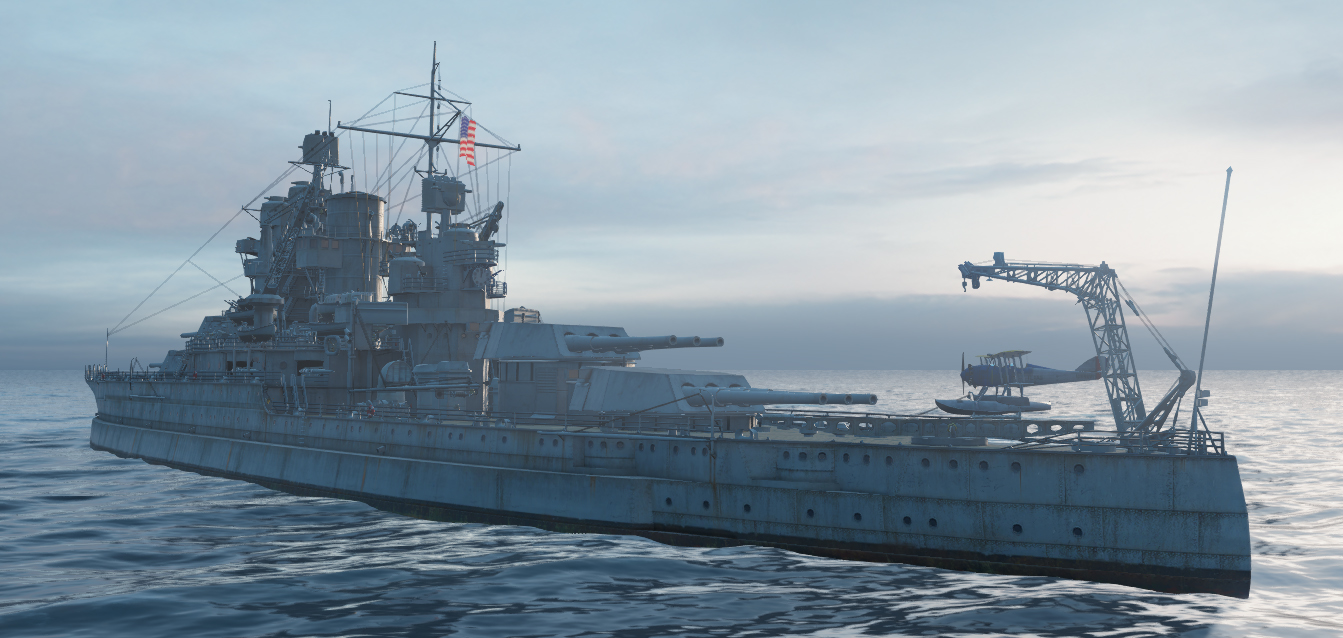
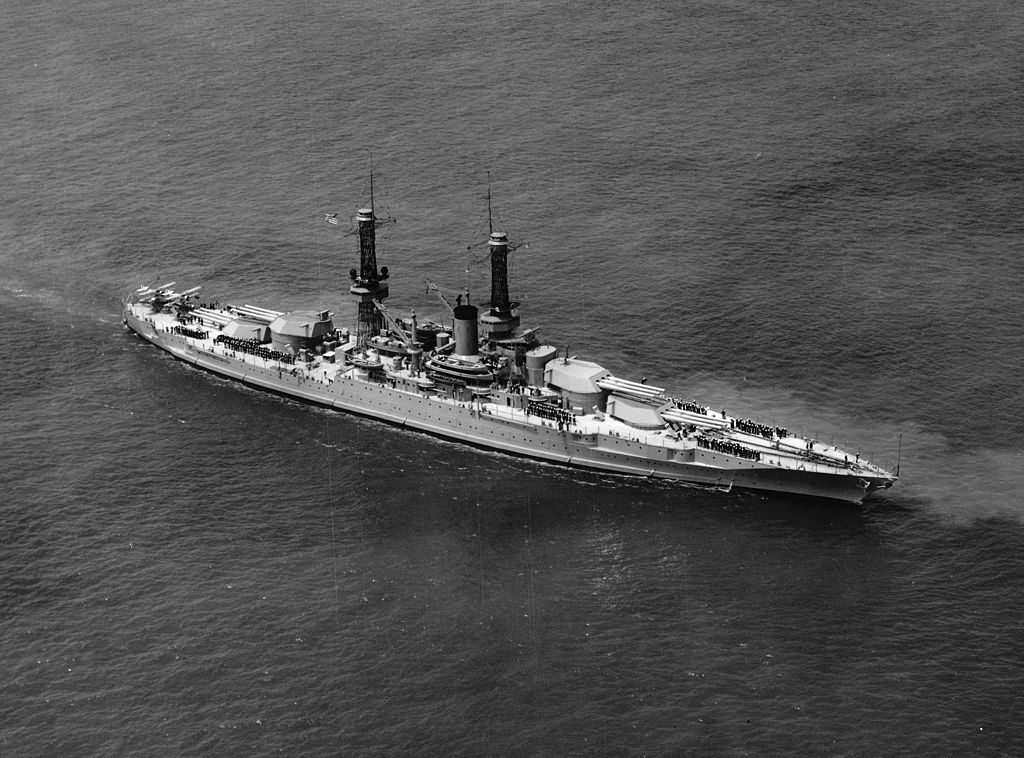
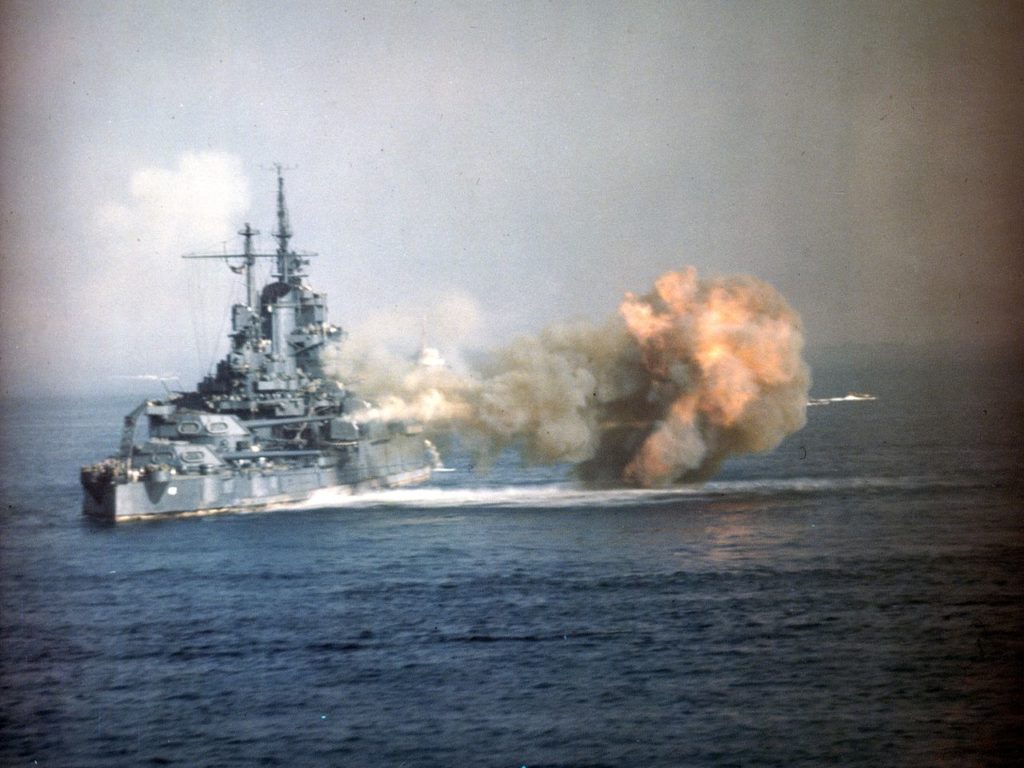

 Latest Facebook Entry -
Latest Facebook Entry -  X(Tweeter) Naval Encyclopedia's deck archive
X(Tweeter) Naval Encyclopedia's deck archive Instagram (@navalencyc)
Instagram (@navalencyc)





 French Navy
French Navy Royal Navy
Royal Navy Russian Navy
Russian Navy Armada Espanola
Armada Espanola Austrian Navy
Austrian Navy K.u.K. Kriegsmarine
K.u.K. Kriegsmarine Dansk Marine
Dansk Marine Nautiko Hellenon
Nautiko Hellenon Koninklije Marine 1870
Koninklije Marine 1870 Marinha do Brasil
Marinha do Brasil Osmanlı Donanması
Osmanlı Donanması Marina Do Peru
Marina Do Peru Marinha do Portugal
Marinha do Portugal Regia Marina 1870
Regia Marina 1870 Nihhon Kaigun 1870
Nihhon Kaigun 1870 Preußische Marine 1870
Preußische Marine 1870 Russkiy Flot 1870
Russkiy Flot 1870 Svenska marinen
Svenska marinen Søværnet
Søværnet Union Navy
Union Navy Confederate Navy
Confederate Navy Armada de Argentina
Armada de Argentina Imperial Chinese Navy
Imperial Chinese Navy Marinha do Portugal
Marinha do Portugal Mexico
Mexico Kaiserliche Marine
Kaiserliche Marine 1898 US Navy
1898 US Navy Sovietskiy Flot
Sovietskiy Flot Royal Canadian Navy
Royal Canadian Navy Royal Australian Navy
Royal Australian Navy RNZN Fleet
RNZN Fleet Chinese Navy 1937
Chinese Navy 1937 Kriegsmarine
Kriegsmarine Chilean Navy
Chilean Navy Danish Navy
Danish Navy Finnish Navy
Finnish Navy Hellenic Navy
Hellenic Navy Polish Navy
Polish Navy Romanian Navy
Romanian Navy Turkish Navy
Turkish Navy Royal Yugoslav Navy
Royal Yugoslav Navy Royal Thai Navy
Royal Thai Navy Minor Navies
Minor Navies Albania
Albania Austria
Austria Belgium
Belgium Columbia
Columbia Costa Rica
Costa Rica Cuba
Cuba Czechoslovakia
Czechoslovakia Dominican Republic
Dominican Republic Haiti
Haiti Hungary
Hungary Honduras
Honduras Estonia
Estonia Iceland
Iceland Eire
Eire Equador
Equador Iran
Iran Iraq
Iraq Latvia
Latvia Liberia
Liberia Lithuania
Lithuania Mandchukuo
Mandchukuo Morocco
Morocco Nicaragua
Nicaragua Persia
Persia San Salvador
San Salvador Sarawak
Sarawak Uruguay
Uruguay Venezuela
Venezuela Zanzibar
Zanzibar Warsaw Pact Navies
Warsaw Pact Navies Bulgaria
Bulgaria Hungary
Hungary

 Bundesmarine
Bundesmarine Dutch Navy
Dutch Navy Hellenic Navy
Hellenic Navy Marina Militare
Marina Militare Yugoslav Navy
Yugoslav Navy Chinese Navy
Chinese Navy Indian Navy
Indian Navy Indonesian Navy
Indonesian Navy JMSDF
JMSDF North Korean Navy
North Korean Navy Pakistani Navy
Pakistani Navy Philippines Navy
Philippines Navy ROKN
ROKN Rep. of Singapore Navy
Rep. of Singapore Navy Taiwanese Navy
Taiwanese Navy IDF Navy
IDF Navy Saudi Navy
Saudi Navy Royal New Zealand Navy
Royal New Zealand Navy Egyptian Navy
Egyptian Navy South African Navy
South African Navy






























 Ukrainian Navy
Ukrainian Navy dbodesign
dbodesign